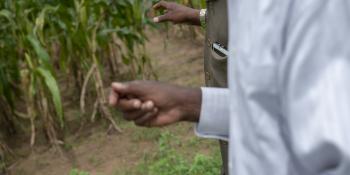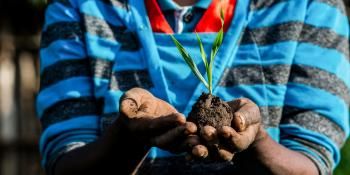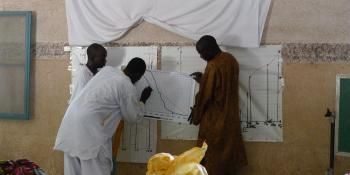Seeds without borders: sharing crop diversity to adapt to climate change

Michael Halewood of Bioversity International reports on the workshop ‘Mutual Implementation of the Plant Treaty and the Nagoya Protocol in the context of wider policy goals’, held Nov. 16-20 in Addis Ababa.
Why this meeting matters
As the media headlines asked this week whether Ethiopia can survive its worst drought in decades, 11 interdisciplinary African country teams gathered in Addis Ababa to look at policies to deal with the impact of climate variability on their agricultural systems. The participant countries were Benin, Burkina Faso, Côte d’Ivoire, Democratic Republic of the Congo, Ethiopia, Kenya, Madagascar, Mali, Malawi, Senegal and Uganda.
A report by the CGIAR Research Program on Climate Change, Agriculture and Food Security (CCAFS) shows that some crops which are vital for food security in Africa’s rain-fed agricultural systems, such as maize, common bean and banana, are facing climate-related losses of up to 40%. This means that countries urgently need varieties of these crops, or even different crops altogether, which can adapt to the changing conditions, both now and in the future. Sometimes those crops can be found within their own borders. But increasingly, farmers and breeders are having to look for gene-based traits in plant genetic resources from other countries. The meeting focused on how countries can identify and access diversity they need and share associated benefits.

On arrival: participants from 11 African countries meet at the African Union Commission in Addis Ababa to discuss ways of promoting integrated implementation of the Plant Treaty and Nagoya Protocol. Photo: Bioversity International.
Out of the silos
The really unique part of this workshop was that we brought together five experts from each country for whom the use of plant genetic diversity already is – or should be – really relevant: ministries of agriculture and environment; climate change specialists; national focal points for the Nagoya Protocol and International Plant Treaty, GEF operational focal points, and last, but certainly not least, national ministries finance and planning.

Participants brainstorm during a group work session. Photo: Bioversity International
For some, it was the first time they became aware of the potential of agricultural biodiversity to help them meet their national development goals, and for many, it was the first time they had the opportunity to meet and work together with their counterparts from the same country. To see them discussing options for longer-term mainstreaming implementation of the two agreements into national development plans, medium term expenditure frameworks, climate change adaptation plans, and biodiversity strategic action plans, and for shorter-term joint activities was just fantastic.
Into the field
We spent much of the first day explaining what the Plant Treaty and Nagoya Protocol are, and how – if properly implemented – they can contribute to climate change adaptation, and ultimately, food security. What really brought the message home was a joint presentation given by Bioversity International scientists showing how it works in practice, through CCAFS supported research projects.
They highlighted how accessing and using genetic diversity can boost national capacities to adapt to climate changes with examples from in Ethiopia, and from Zambia and Zimbabwe. They showed how to work with teams of farmers and national researchers to identify climate related stresses on local cropping systems, identify and obtain potentially adapted crop genetic resources from around the world, and evaluate their performance in the same stressed areas. These practical examples helped those participants whose work is focused primarily on high-level finance and development planning to appreciate the potential for linking-up access and benefit-sharing policies and climate change adaptation strategy development. This really drove the message home to everyone about why investing in genetic resources and putting systems in place to ensure they can access and use it really matters.
Off to the African Union Commission
One of the highlights of the week was the opportunity for everyone to meet with the African Union Permanent Representative Committee Sub-committee on Programs to discuss ways of promoting integrated implementation of the Plant Treaty and Nagoya Protocol into both national and regional development programming. Having the opportunity to discuss the opportunities and challenges faced at the country and regional level, based on syntheses developed by the experts at the workshop was a fantastic opportunity.
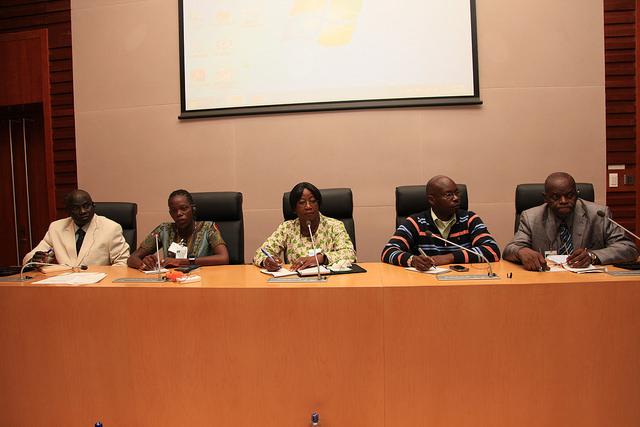
Five of the workshop participants. Photo: Bioversity International
The AU’s recently published Agenda 2063 includes in its seven aspirations that “the environment and ecosystems are healthy and preserved with climate resilient economies and communities”. In 2015, the AU also adopted the African Union Practical Guidelines for the Coordinated Implementation of the Nagoya Protocol in Africa. The Guidelines mention climate change and the Plant Treaty, but does not address how it should be implemented. Participants at the AU meeting emphasized the importance of developing additional tools to be considered at the level of the African Union to address Plant Treaty implementation, linked specifically to climate change adaptation.
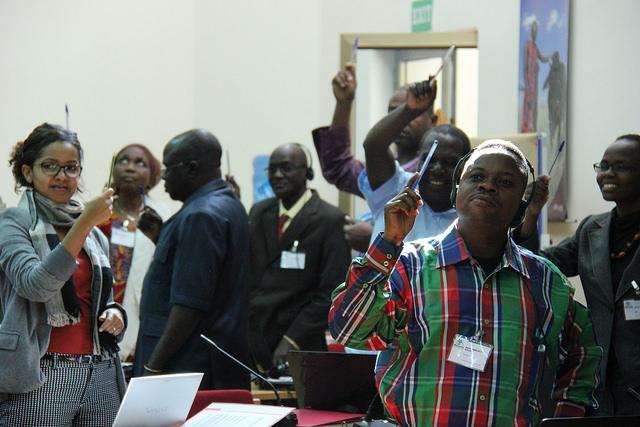
Group work, debates and shows-of-hands defined this highly interactive event. Photo: Bioversity International
The next steps
What is important now is that the groups can go back to their countries and continue to develop their plans to implement these two agreements together in support of their climate change adaptation and development agendas, with the momentum and enthusiasm they have gained during this week.
Next on our agenda at Bioversity International, is the development of a decision-making tool to help support the mutual implementation of the Plant Treaty and the Nagoya Protocol in the context of climate change adaptation, food security and development goals that we know from feedback in the workshop will be very welcome.
To see all the presentations, recommended reading and photos from the Workshop, please click here
Partners
This week-long workshop was held in Addis Ababa, Ethiopia, November 16-20, and organized by Bioversity International and the ABS Capacity Strengthening Initiative, in partnership with the International Treaty on Plant Genetic Resources for Food and Agriculture, the Convention on Biological Diversity, the African Union, the CGIAR Research Program on Climate Change, Agriculture and Food Security and the Japan Biodiversity Fund.
Michael Halewood is Theme Leader of Bioversity International's research area "Policies for Crop and Tree Diversity Management".

